Where: Seoul, capital of South Korea.
When: Many visits between 2011 and 2014.
Why: I spent three years teaching in Korea. In my first year of teaching, J and I lived in Dongtan, which is a new city about an hour south of Seoul, so we visited here once or twice a month for shopping, partying, culture etc. Our next teaching job was in Geoje, an island off the south coast, at the opposite end of the country; but we would still pop up to Seoul once every two months or so to meet friends, eat good food, go book shopping etc.
>->->->->->->->->->->
Map
>->->->->->->->->->->
Intro
Seoul is the heart of South Korea. It is the nexus from which everything radiates. The heart and hub of the country.
Seoul is a modern metropolis of super skyscrapers and old world palaces, temples and parks and superb shopping. Seoul is exciting and crazy, but also easy to access and navigate. Once you get to know it a little, it’s a great capital city.
Weirdly, in some ways Seoul reminds me of London, in that it has some very distinct districts and almost feels like a set of towns and villages that have grown together. There’s Myeongdong for shopping, Hongdae for partying, Itaewon for the westerners, Mount Namsam for peace and quiet and great views of the city. Downtown, south of the river, there’s the upmarket Apujong and the unpretentious bars and shops of Gangnam. Each district has it’s own joys and characters, sights and smells – and there’s no way that I could cover them all here.
I really like Seoul. It’s exciting, and fun and easy to access and navigate. There’s so many wonderful food options here, loads of cultural things to see, gorgeous mountains to go hike. It’s a very livable, very fun city to be in. There are modern ‘designed’ areas, especially along the river; but the centre of the city is a mish-mash of modern, old, cool, clean, dirty, fun.
South Korea has amazing countryside and other great cities, but Seoul is its beating heart and I hate to say this, but the soul of the country.
->->->->->->->->->->
Getting there
Airports
Seoul has two major international airports: Gimpo International Airport and Incheon International Airport.
Return flights from the UK to Seoul usually cost around £600. I have flown from Birmingham to Korea with Emirates, Lufthansa and Turkish Airlines. All were great, though I think Emirates were my favourite as the journey was split into two, the Seoul flight was on a huge A380 and the sunrise over the Himalayas, which I saw from the plane, was just stupendous.
Incheon Airport is Seoul’s main airport and where the big, inter-continental airlines fly in to. Incheon is regularly voted one of the best airports in the world. It has a cinema, an ice rink, lots of shops, a cultural centre etc. However, it didn’t have many restaurants, basic shops or book shops when I was there, which marks it down in my estimation.
Incheon is located on an island off the west coast of Korea. It has great transport links into central Seoul, including the airport train, the subway and inter-city coaches.
For more information on getting to and from Incheon Airport, visit the Incheon International airport website.
Gimpo Airport is also located to the west of Seoul, but is on the mainland. It is actually closer to the city centre than Incheon. Gimpo tends to handle domestic and local flights, and budget airlines too.
Gimpo is on the subway system and so it’s very quick and easy to get here from the centre of Seoul. It also has a stop on the airport train line.
You can find out about all of the Gimpo aiport transport options on the Gimpo Airport website.
Trains
The main train line which runs up and down the country from Seoul to Busan terminates at Seoul Central Station – which is in the heart of the city. For more information on getting trains in Korea, visit the Ko Rail website.
Coaches
There’s three large coach stations in Seoul: Express Bus Terminal, Dong-Seoul and Nambu.
Express Bus Terminal is located in Gangnam, and you can get coaches from here to most places in Korea. It has a huge shopping centre inside and all the facilities a traveller could need. It’s a big sprawly, concrete bus terminal that is easy to get lost in. Express Bus Terminal has a website, but it is all in Korean.
There’s also a bus station in dong-Seoul (east Seoul), mostly for buses to the east of the country. We went through here on our way to Sokcho. Dong-Seoul bus station also has a website, but it is also all in Korean.
Finally, when we travelled up from Geoje we came into Nambu bus terminal, which is also near to Gangnam in the Seocho area. Nambu is a small bus terminal with a few fast-food outlets, clothes shops and snax stores. The Visit Korea website has more information about the bus station, including how to get there by public transport.
The briliant KoBus website has timetables and ticket prices in English.
->->->->->->->->->->
Getting around
Seoul has a great subway system, which runs pretty much half way down the country. For more information on travelling by Seoul Metro visit www.seoulmetro.co.kr.
There’s also a good bus system but we tended to just use the subway as it was so good and convenient, and sometimes the traffic could get pretty snarly in central Seoul.
Seoul has the T-Money card system, which is like a London oyster card. You can use the T-Money cards on buses or the subway. You can buy T-Money cards and top them up in most convenience shops or at the subway stations.
->->->->->->->->->->
What we did in Seoul
Visited the palaces
Seoul has thirteen palaces. Most of the palaces that you can visit today are actually reconstructions as they were destroyed by the Japanese (in fact you can see some of them currently being reconstructed).
I went to three of the palaces and that was enough for me. They were all very pretty but also very similar, and so they started to blend together after a while and my appreciation went down with each one that I visited. Which was a shame as they were all lovely. All the palaces in Korea seem to have the same structure of large entry courtyard, second courtyard with throne room, back courtyards where the business of the palace took place and where normal peeps would live, maybe with an occasional relaxing room thrown in, or a pond or garden.
They are all very pretty but mildly boring as the rooms are mostly empty and the buildings all have the same decorations and all of the courtyards look the same.
Anyway, I visited the following:
Deoksugung Palace
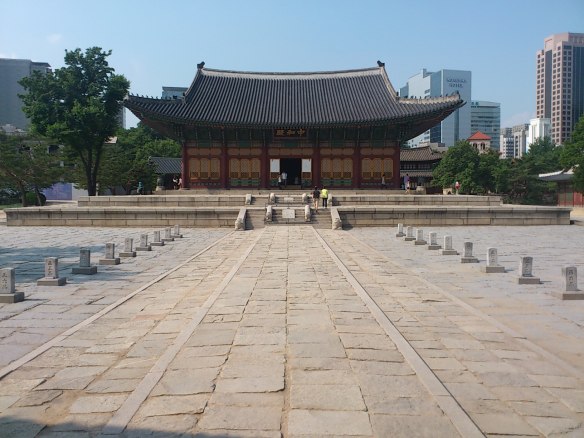
Deoksugung Palace is located in the centre of the city, next to City Hall. The gateway to the palace overlooks the City Hall Plaza area.
Deoksugung was the first of the palaces that I visited in Seoul. I wasn’t planning on going to Deoksugung, but I passed the changing of the guard ceremony (see top of page) and it looked great, so I went to investigate.
The changing of the guard ceremony was a lot of fun. There were soldiers with fake beards, in traditional dress, marching around with huge flags and drumming.
When it was over all of the soldiers marched away towards City Hall. But very sensibly they waited for the little green man to let them across the busy main road, in formation (I found this hilarious for some reason).
Anyway, because I was by the palace I decided to go in and I was delighted to find out that entrance to the palace was only ₩1,000 (about 70p).
Deoksugung Palace is set in lovely grounds with lots of shady trees to relax under and soft music playing (on repeat – by the time I left I was getting a little sick of it).
Deoksugung Palace is only a little palace, compared to the others, but I liked it. It was cosy and homely and because the palace is more modern, the different areas had been built in different styles, which made it more interesting. This palace didn’t have the empty courtyard after empty courtyard found in the other palaces. Also the palace and the grounds seemed to blend together more, which I liked.
At the back of the palace grounds there were some very old ‘national treasures’: the huge, old Bell of Heungcheon Temple, which was made in the 14th century; a machine that can fire over 100 arrows at once, which was one of the first guns; and the remains of the oldest water clock in the world.
There were two modern buildings in the palace complex which contained the National Museum of Contemporary Art, but I didn’t go into these as I was on a palace mission.
Deoksugung felt more like a lovely park which happened to have relics in, rather than a palace, and I think this is partly why I liked it so much.
If I was looking for some time out and peace and quiet in the heart of Seoul, this is where I’d go to.
Incidentally, if you are from the UK and you lose your passport, the British embassy is just to the north of this palace. I have heard rumours that there is a proper British pub in the embassy.
Deoksugung opens from 9.00 to 21.00 every day, apart from Mondays when it is closed. The nearest subway station is City Hall.
Gyeongbokgung Palace
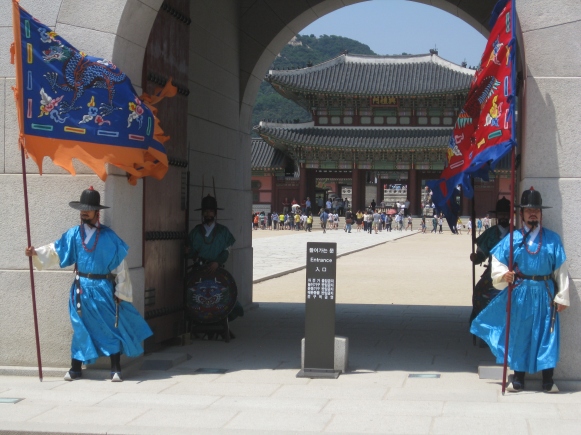
Gyeongbokgung Palace is the main palace in Seoul and possibly the most famous tourist attraction in the city. It is the largest of the palaces, located to the north of the city centre.
I walked from Deoksugung to Gyeongbokgung, via Gwanghwamun Plaza. Gwanghwamun Plaza is a wonderful open space, which contains lots of fountains and huge statues of Admiral Sunshine and King Sejong (King Sejong has an exhibition space under him).
At the front of Gyeongbokgung Palace is Gwanghwamun, the main gate. This has been rebuilt twice. It was rebuilt in 1968 out of concrete but the alignment was slightly out, so in 2010, the Koreans knocked it down and rebuilt it again. It is very impressive.
There are guards with fake beards guarding Gwanghwamun (I know they are fake as I saw one of the guards take his beard off) and the guards march about and shout occasionally, which is fun to watch.
Out of all the palaces, Gyeongbokgung was my favourite. It’s the most impressive and, to my mind, it is a proper palace. In particular I loved the huge outer courtyard, where I could imagine armies amassing; the throne room (also known as the Hall of Diligent Government or Geungjeong-jeon); the Hall of Worthies, where the Korean alphabet was developed; the lake side pavilion and the pagoda on the lake at the back of the complex – this was beautiful (see below). I also loved the setting of Gyeongbokgung. It looks wonderful with Mount Bukhansan in the background. I really felt as if I was in an ancient land, not in the centre of the crazy modern metropolis of Seoul.
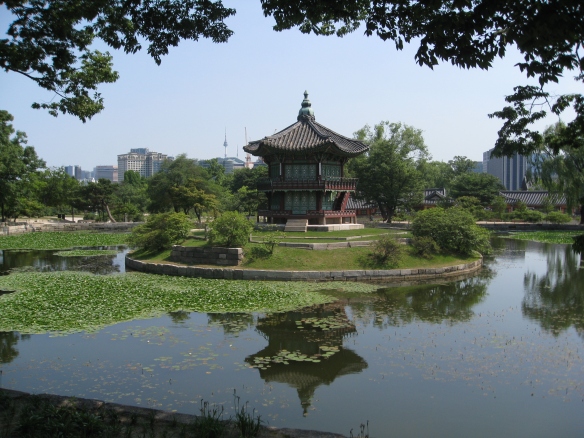
Entrance to the palace was ₩3,000 (about £2), which I think is a bargain for a site so important and prestigious as this.
You can find up to date information about visiting the palace on the Visit Korea website.
There is also a palace museum and a folk museum, but when I visited it was hot and I was tired and so I’m afraid I didn’t go in either of these. J has been to both the museums and he says both are good and the museum is good for warming up or cooling down in, depending on which season you visit.
Changdeokgung Palace (UNESCO)
I feel a bit sorry for Changdeokgung Palace as by the time I visited here I was palaced out. I wanted to go here as it’s the only palace which is UNESCO listed and because Lonely Planet said it was the one palace not to be missed. I’m not sure why though. I don’t know if it was because I had palace fatigue by the time I got to Changdeokgung, but I found Gyeongbokgung Palace to be much more impressive and interesting.
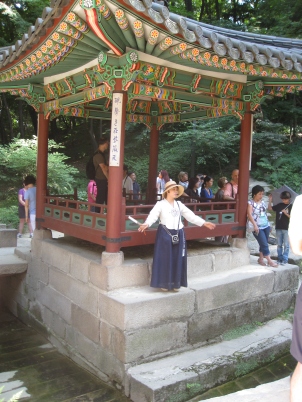 Lonely Planet recommends that you visit Changdeokgung Palace because of the secret garden hidden at the back. Though this is a very pretty area, it just reminded me of the ubiquitous pavilions and pagodas that you find elsewhere in parks across Korea. Don’t get me wrong – it was very nice – but slightly boring. The only part of the complex which I liked was the waterfall where the king played drinking games.
Lonely Planet recommends that you visit Changdeokgung Palace because of the secret garden hidden at the back. Though this is a very pretty area, it just reminded me of the ubiquitous pavilions and pagodas that you find elsewhere in parks across Korea. Don’t get me wrong – it was very nice – but slightly boring. The only part of the complex which I liked was the waterfall where the king played drinking games.
I was slightly frustrated with the palace before I even went on my tour, as they said you could only visit the palace and the gardens on separate guided tours, but the English tours for the palace and the grounds both left at 14.30 – so there was no way that I could be on both.
I asked the ticket lady where to meet the garden tour and she said at the ticket booth, but no guide came. Eventually I made my way into the complex and found out that I didn’t need a guide to see the palace; and then I found out that my Secret Garden tour (which cost more) actually left from the Secret Garden entrance and had already left. However, they did let me catch them up.
I wish I’d been able to visit the gardens on my own because I couldn’t understand a word the guide was saying (in English) and because these gardens are special because of their peace and serenity – and visiting with a huge tour group of 50 people defeated the magic.
The rest of the palace complex, to me, was kind of boring as it just reminded me of the other palaces which I’d already visited.
Maybe if I’d seen Changdeokgung first I might have liked it more. As it was, I just found it a bit dull; although I am glad I can tick another UNESCO world heritage site off the list.
The palace guided tour cost ₩3,000 (£2), the Secret Garden guided tour cost ₩5,000 (£3.50). The English Secret Garden tours took place at 11.30 and 14.30. Closed Mondays.
Jongmyo Shrine (UNESCO)

Jongmyo is the sacred shrine where the spirit blocks of the past Kings and Queens are housed. The spirit blocks have holes in, in which the royal spirit resides. As I wanted to add another UNESCO site to my list and I quite fancied going to see the spirits of the old kings and queens (well, I’ve seen John the Baptist’s arm) I decided to pop to Jongmyo whilst waiting for my tour of Changdeokgung Palace, as the two sites are next door to each other. Sadly for me Jongmyo is not open on a Tuesday so I had to come back later on.
Unlike Changdeokgung, at Jongmyo I was able to buy an unguided ticket (₩1,500, about £1) so that I could see the site for myself and visit at my own pace; but when I got to the gate they told me that even though I had bought an unguided ticket – I was only allowed in on a tour.
As I hadn’t been able to understand the English guide at Changdeokgung and as I saw that they had printed English guides and information boards, I decided to join the next tour (which was in Japanese) rather than wait an hour for the English tour.
The shrine has a beautiful setting in a forested park with some lovely pools, but much of the complex looks exactly the same as the other palace’s buildings and so I found a lot of the trip to be slightly dull. Maybe I should have waited for the English tour to get more context.
However, the spirit halls are very impressive and I liked the spirit paths (the spirit would walk on the central path, the king and crown prince on paths on either side of them). You’re not really supposed to walk on these but a lot of people did. I also liked reading about the rituals that take place here each year, where they create huge spirit feasts for the kings and queens; it must be very impressive to see.
I hoped that I’d be able to see the spirit blocks, but they are not for public viewing. I shouldn’t be flippant about the spirit blocks, as to many people they are still sacred and precious. Many Koreans really do believe that their royal ancestors reside in these blocks and that’s why this is such a sacred site. They’re not a tourist attraction.
Guided tours take place in English at 10.00, 12.00, 14.00 and 16.00. You can take a self-guided tour on Saturday (I’d do this if I were you).
The Visit Korea website has up to date information about visiting the shrine.
Seonjeongneung (UNESCO)
Located in the south of the city, close to Gangnam is Seonjeongneung. Seonjeongneung is a small park which contains the burial mounds of King Seongjong (1469-1494), his wife Queen Jeonghyeon, and King Jungjong (1506-1544) of the Joseon Dynasty (1392-1910).
This is a gorgeous space, forested, natural and cool, surrounded by tower blocks.
I’ve visited twice and both times I have spent about an hour having a relaxed, wander here. It’s a lovely space and there’s some interesting statues on the burial mounds.
You can find out more about the site and how to visit on the Visit Korea website.
Namdaemun

Namdaemun is the main gateway to Seoul. It is national treasure number one. The gate was originally built in the 1400s. In 2008 it was severely damaged when someone tried to burn it down.
For most of our time in Korea we couldn’t visit Namdeamun as it was wrapped in tarpaulins, being restored. We’d drive past it most times we visited Seoul, but it was wrapped up, and it was only just before we left that I was able to go see Korean national treasure number one in the flesh.
The gate sits in the middle of a park, in the middle of a busy intersection. It is very impressive and very imposing and quite pretty. It’s free to go visit and walk through though a visit only takes about ten minutes.
You can find out all about Namdeamun and its history on its Wiki page.
Mount Namsam, N Seoul Tower and the cable car
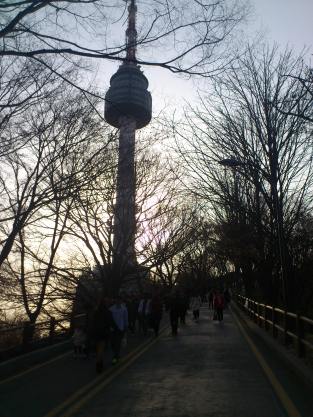
Mount Namsam is the huge mountain, park area in the center of Seoul. Many of the city centre buses travel through the tunnels under Mount Namsam to get around.
The first time we went up Mount Namsam, we were very hungover after drinking buckets the night before and we thought that the air might be slightly fresher at the top of Mount Namsam and we might be able to blow away the cobwebs up there.
Mount Namsam is very steep. Luckily for us, there was a fun, little, electric public bus which ran up the mountain and we caught this. It was bus number 2. Bus 3 and 5 also go to the top of the mountain.
At the top of Mount Namsam is the N Seoul Tower, an observation tower. To be really honest with you, the views from the bottom are just as good as the views from the top, but it’s interesting to go up the tower and there is a restaurant and a coffee shop at the top. The restaurant rotates and J and some friends once visited here on New Year’s Eve. It’s expensive but also an interesting, unique treat.
At the base of N Seoul tower there are some good, fast-food options, including a Cold Stone for delicious ice creams.
Tickets for adults to the observatory cost ₩7,000.
The walls of old Seoul run up and across the mountain and you can see these and also climb onto the high defensive position where the relay bonfire thingy is.
There is a cable car which runs up the mountain. This cost us 6,000 won each (about £4).
I’ve climbed Namsam a few times. My co-teacher Priscilla and I went here for a Sunday walk when we were desperately looking for signs of spring. The route up the mountain from Myeongdong is quite gentle, there’s great views of the north of the city and we went past some interesting shrines. The route which follows the path of the cable car, which I did at the height of summer, is much more steep and just goes straight up. Again, there are pretty views though and lots of benches for resting.
Insadong
Insadong was a nice, touristy part of Seoul with lots of old shops and buildings. It may have changed since I last visited though, as when I left there were rumours that this wonderful, atmospheric, old part of the city was going to be developed and a lot of the old buildings knocked down. Hopfully, this didn’t happen, as Insadong is one of the most genuinely Korean areas of this modern metropolis.
If you want to buy souvenirs or feel as if you are in old Korea, this is the place to head to. Insadong is located between Gyeongbok Palace and Tapgol Park. There are lots of art galleries, cool, alternative shops and this is a nice place for pottering about. There is one main shopping street which runs through this area and then lots of little alleys running off it. We went to Insadong to do our Christmas shopping, visiting old tea houses and the cool shopping arcade with the alternative shops. Insadong reminds me of Convent Gardens in London.
You can find out more about Insadong on the Visit Korea website.
Shopping
Korea is the land of shopping and Seoul is the capital of the land of shopping. I could tell you to go to a particular area but to be honest there are shops everywhere, so just go to Seoul and you can shop.
Namdaemun Market is a huge market and where a lot of the guide books recommend that you go. They have clothes, random household stuff and antique stalls. We went on a wet day and got bashed around a lot by umbrellas. It was so overcrowded with people and stock that I didn’t really enjoy shopping here, I’d much prefer to go to one of the underground malls.
Myeongdong has lots of high street stores, including H&M and Forever 21. There’s lots of cool, independent shops around the back streets. This was my favourite place for shopping, though it could get incredibly crowded on a Saturday.
My other favourite place for shopping was Gangnam, as there was one long road with pretty much all of the shops that I needed and a huge underground mall at Gangnam underground station. The mall at the station was a brilliant place for picking up bargains – especially funky outfits, jewelery and logo T-Shirts. The lack of daylight did get to me after a bit, and I’d have to venture above ground occassionaly; otherwise I could spend hours browsing down here.
There are malls in Seoul as well, including the huge Co-Ex mall, but I never got round to investigating those. I mostly just shopped in the underground stations.
Special note should go to What the Book, which is the best English book store in Korea. What the Book is in Itaewon and they sell new and second hand English books. I would make special trips to Seoul just to go to What the Book.
Take a walk by a stream
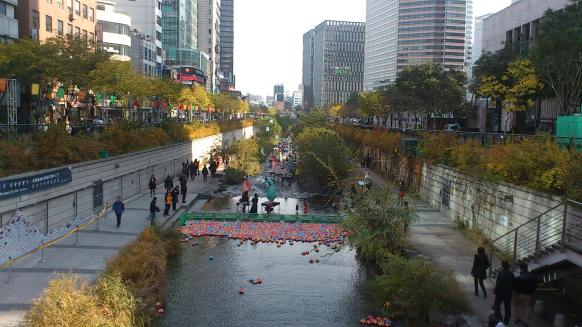
The Cheong-Gye-Cheon runs through the centre of Seoul. This used to be a horrible stream: disused, dirty and with roads running over it; until it was restored and rejuvenated. Today it is a strange natural/unnatural river with stepping stones, waterfalls, water cinemas, art work etc alongside it. What is nice about the Cheong-Gye-Cheon is that although the river banks are so obviously manmade and fake, nature has started to come back to the river and whilst I was there I saw fish and herons using the waterway. It’s very pretty and a watery artery through the central business district, and quite a good route to take to get to different parts of the city.
They have concerts and lazer light shows by the river in summer, and when we visited on Buddha’s birthday there were wonderful, huge paper lanterns floating on the water.
National Museum of Korea
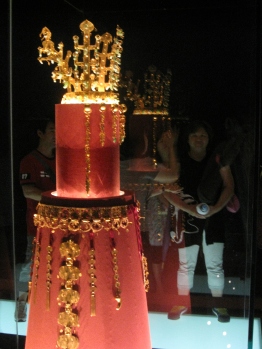 The National Museum of Korea holds many treasures from Korea. It is in a gorgeous building and is free to visit. There’s loads of treasure in here, and really interesting items in here, but I soon became overwhelmed by the objects and so just ran through, looking at anything that caught my eye. It may be much better to visit the museum with a guide or to hire an audio-guide, so you can get more context about the items, without having to read all of the information cards.
The National Museum of Korea holds many treasures from Korea. It is in a gorgeous building and is free to visit. There’s loads of treasure in here, and really interesting items in here, but I soon became overwhelmed by the objects and so just ran through, looking at anything that caught my eye. It may be much better to visit the museum with a guide or to hire an audio-guide, so you can get more context about the items, without having to read all of the information cards.
Visiting the museum is a good thing to do on a rainy day.
Ichon station, exit 2.
JSA and DMZ tour
The tour to the North/South Korea border departs from Camp Kim, which is in Seoul. For more information on visiting the demilitarized border area (DMZ), visit the DMZ page.
Seoul Grand Park, Zoo and Modern Art Museum
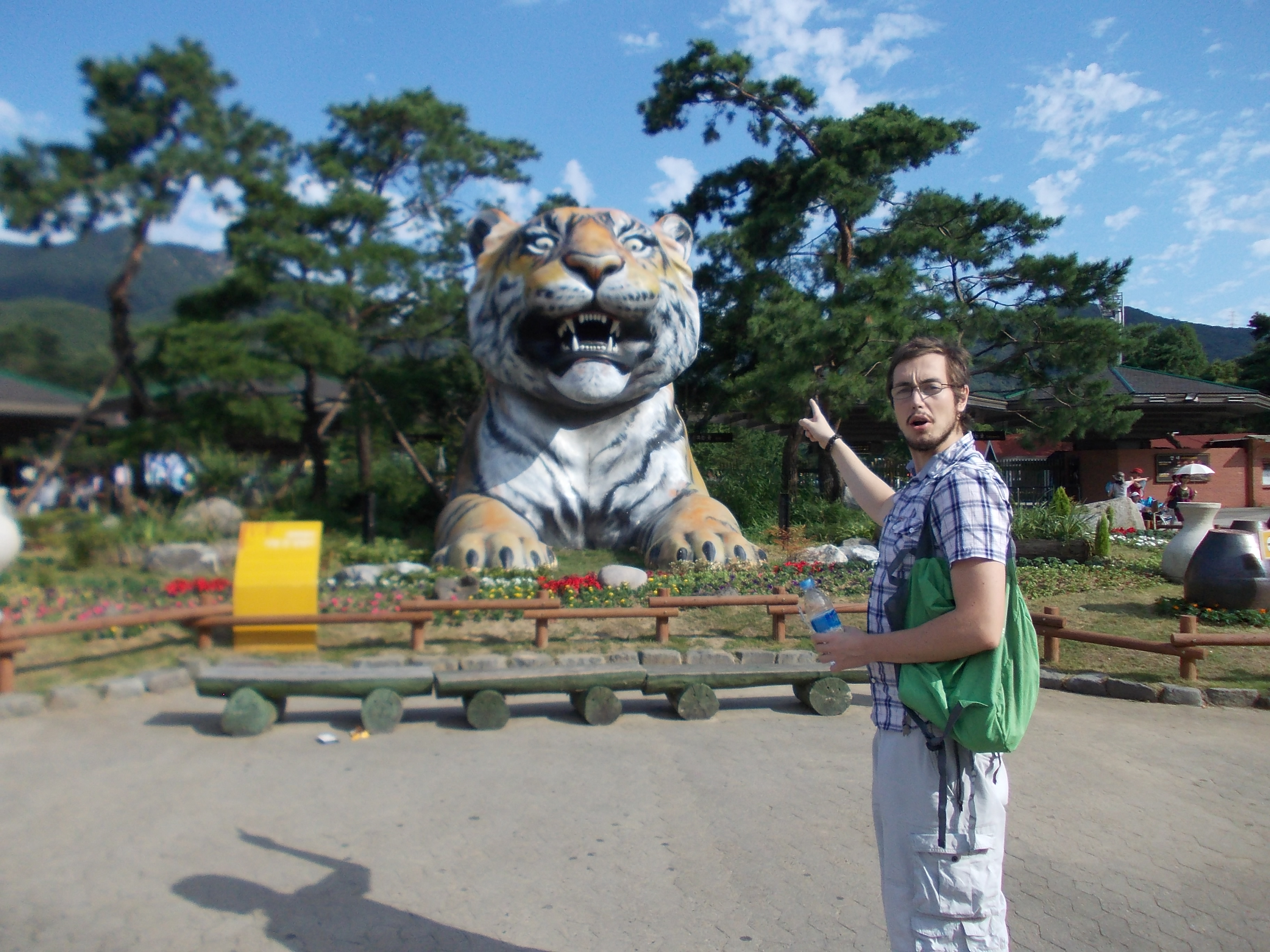
To the south of Seoul is Seoul Grand Park. In the park they have an ace zoo, a brilliant modern art museum (free), a lake, a theme park and some expo centres. It’s a nice place to visit on a Sunday and a good place to go to if you want to get out of the city. They also have crazy chair lifts which fly high above the zoo and the lake. These are fun.
The park has it’s own subway station on Line 4. Entrance to the zoo was ₩3,000 won per adult and it’s ₩5,000 won for two trips on the sky lift.
grandpark.seoul.go.kr/engMain.jsp
Bukhansan
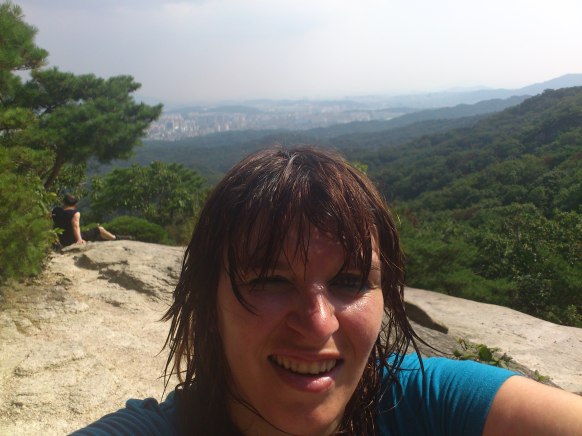
Bukhansan is a mountain to the north of Seoul which I have tried to climb on a number of occasions, but I have never reached the top. Some of the routes up are relatively easy but many of them are pretty tough and on the three times I’ve tried to get to the top there were places where I had to use ropes to climb the way, which was a bit scary.
There are lots of paths running up the mountain, hidden temples, rivers, bridges, streams, cafes and toilet blocks etc. It’s absolutely beautiful and a great place for hiking. This is a great place to head to if you want to get out of the city and want some fresh air and exercise.
At the base of the mountain there are loads of discount hiking stores, cafes and an information centre. Dobongsan Station on line 1.
To find out more about climbing Bukhansan and what there is to do and see on the mountain visit the Bukhansan National Park website.
Gangwha-do
A great day trip or weekend get-away from Seoul is to visit Gangwha-do, an island off the west coast that borders North Korea. There is a direct, local bus from Sincheon to Gangwha-do, which takes about two hours. You can find out all about Gangwha-do on the Gangwha-do page.
Buddha’s birthday lantern parade/ Lotus lantern festival (Yeon Deung Hoe)




Buddha’s birthday is a national holiday in Korea and in many places it is celebrated with a lantern parade. Local temples create beautiful, coloured lanterns to decorate the temples, and huge floats are created for the parade.
We got the date wrong for the parade, we actually went to watch it a week too early; so instead of having a wasted trip, we went to have a look at the lanterns being created at Jogyesa Temple, which is close to Gyeongbokgung Palace.
We returned the next week, the correct weekend for the parade, and first we went to see the lanterns floating on Cheong-Gye-Cheon stream, then we went to Jongno Street to see the main parade. The parade was wonderful. It was made up of groups of worshipers from different temples in traditional dress, carrying lit lanterns or pushing huge lantern floats. It went on and on and on and on: it must have lasted for over two hours. There were dragons, big Buddha’s, lotus flowers and monsters. There were drums and music. It was the most wonderful carnival and there was a great, fun, joyful atmosphere.
Eventually we got hungry and so we went to watch the parade from above from Jongno McDonalds.
It was one of the most wonderful festivals we saw in Seoul and if you are in the city at this time, I would highly recommend that you come to see it.
Find up to date information about the parade (including the correct date) on the Visit Korea website.
Christmas Market
Living in Korea, it wasn’t England that I missed it was Europe. And one of the things that I missed most was European Christmas Markets. Luckily, the Seongbuk Global Village Centre put on a Christmas Market each year in Seongbukcheon, by Hansung University Station, and we were lucky enough to go to this.
The Christmas Market was a lot of fun: they had loads of food from around the world, mulled wine and Korean Santas singing samba music.
The mulled wine sold out extremely quickly and there were big queues, but it was a lot of fun and a great taste of far-away home.
The Seongbuk Global Village Centre has a useful website with information about living in Seoul, and a good source of courses and opportunities for foreigners.
International Festival, Itaewon
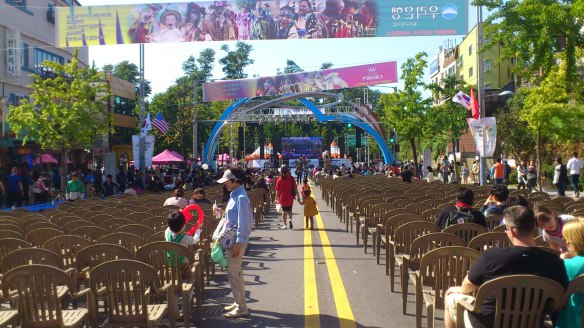
Not to be outdone by their Seongbuk sisters, the Itaewon Global Village hold an international festival too. At the festival they close Itaewon high street to traffic and lots of food stalls are set up, with food from around the globe. The British store sold chicken kebabs, which I’m not sure is that accurate but hey-ho. The festival took place on a sunny day in the autumn and I had a lovely day sampling all the food and drinks, eating things that I didn’t often get access to and watching the entertainment. In the day time there was a great family atmosphere. Knowing Itaewon, it probably got a bit more messy later on.
There’s an Itaewon Global Festival page on facebook.
->->->->->->->->->->
Nightlife and entertainment
Nanta
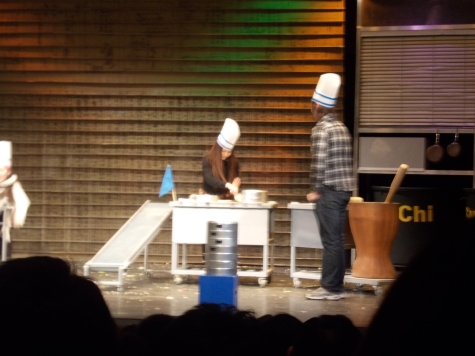
Nanta is the Korean stage show which is a little like Stomp, but set in a Korean kitchen. The actors use the kitchen and the cooking implements to drum and dance. It’s a Korean institution and if you have a spare afternoon or evening in Seoul I’d highly recommend it as it is a lot of fun and a great way to spend a few hours.
There are four theatres in Seoul which show Nanta. J took me to the show for my birthday and we went to the Myeongdong theatre. The show is great and fun and easy to understand.
Watch out though – you might get dragged onto stage like J did.
Eating and drinking
I’ve travelled a lot and I can honestly say that Seoul is one of the best places in the world for partying. There’s a huge amount of fun, crazy bars and drink prices are pretty reasonable in most places.
There’s also a huge selection of great food places. All the world’s kitchens can be found here if you know where to look, and there’s an exciting and vibrant food scene in Seoul.
Life in Seoul moves fast and businesses open and close in the blink of an eye, so a lot of the places mentioned below may be closed by the time you read this. Therefore, if you’re looking for the most-fun places to go check out Groove Magazine (which has a great listing section), Time Out Seoul or World’s Best Bars.
The big party areas in Seoul are:
Hongdae
Area around the university with loads of bars. Possibly the best place in Korea for drinking. There’s loads of pubs, clubs, shops, cafes, nightlife and craziness going on. You can head to a pretentious Korean club such as Cocoon or one of the cheap Hof bars, or just go and have some food and a shop.
There’s often street music and night markets, and there’s a nice little park in the centre and this seems to be a focus for a lot of the partying. They sometimes hold silent discos here.
My one recommendation with Hongdae is that if you are meeting people there get a map or travel with them – as both times we have been we have gotten hopelessly lost as there are just so many bars.
Also there’s not a lot of accommodation in Hongdae, so if you are staying over the best place to stay is neighbouring Sincheon.
Hongdae can be fratty but it can also be a lot of fun.
Favourite bars of ours were Shamrock and Roll and GoGos nightclub.
Itaewon
Itaewon is located on the lower slopes of Namsan and is pretty close to the US army base. Itaewon is very Western and it has a lot of Western bars and shops, including What the Book, the English language book store. There’s loads of international restaurants and bars including some great Mexican restaurant, tapas, French food, Turkish food, Uruguayan food, Austrian, a Canadian pub, international food stores and a great Irish bar called Wolfhound.
Vatos Urban Tacos is one of the most famous restaurants in Itaewon. It is a wonderful Mexican/Korean fusion place which serves interesting street tacos and great Margaritas. There was usually a queue outside, though you could pre-book. For my birthday we went to Los Amigos, which was a fab, fun, bright Mexican restaurant which served good fajitas and large cocktails.
The Rose and Crown is a typically English pub, located down one of the back streets. Great place if you’re missing home.
Bungalow was a crazy place, which had indoor hot tubs and mini-beaches (they were like indoor sandpits). It was a lot of fun, though a little bit pricey.
Nashville has a great roof-terrace and serves jugs of cheap beer. It’s a wonderful place to go in summer, especially on a clear day. We saw an amazing Seoul sunset here.
If you want to have a night out and to pretend that you are not in Korea – this is the place to head to.
Only Itaewon has a good directory of bars and restaurants.
HBC
HBC is Haebangchon. It’s located between the American army base and Itaewon. It’s the new Itaewon with lots of cool bars, two micro-breweries, pop-up eateries, great restaurants, hip shops and second hand book stores.
Our favourite places here were the Booth (which served the best summer ale I have ever drunk along with great slices of salty pizza), Magpie Brewery and Craftworks – which was the original micro-brewery, but which gets incredibly busy.
Tripping has a great beer lovers guide to Seoul, which features many of the HBC pubs.
There’s a great annual beer festival in Itaewon and HBC around May time – where you buy vouchers and then go round the pubs trying the real ales.
Apujong
Apujong is a more exclusive area of this city. This is where the high end stores are. We went to a club here called Monkey Beach – which is named after Monkey Beach in Koh Phoi Phi and which served buckets. It was alright, but very fratty.
Gangnam
Even though we regularly went to Gangnam for shopping and transport, it took us nearly two years to go there for a night out, and it wasn’t what I was expecting at all. Gangnam is all neon and bright flashing lights so I was expecting it to be fratty, drunken and messy, but the bars we went to were actually great ex-pat hangouts and very chilled out. We went to a couple of pilsner brewery beer bars, before ending up at Woodstock, a chilled out, locals bar where we were able to choose the music ourselves.
Mine and J’s date place was Vapianos in Gangnam. Vapianos is a chain of fresh pizza and pasta restaurants, which we have also visited in Tallinn and London.
Rainbow is a hookha bar that lots of my friends went to, but I never made it. They also used to go to Pandora’s Cocktail lounge, which serves unlimited cocktails for ₩20,000 for men (£10) and ₩10,000 for women (£5).
Hyehwa
Hyehwa is not one of the most popular areas to go out to play, but we went for a night out here and they had a surprisingly large number of cool bars.
Jazz Story is a cool place with a wall of records, velvet chairs and crazy-metallic structures on the outside.
There were loads of other cool little places, but sadly I haven’t been able to find them on the internet. Hye-ho.
Little Silk Road, Dongdaemun History and Culture Park station
At the back of Dongdaemun, close to Dongdaemun History and Culture Park station, there is a cluster of Central Asian restaurants. Our favourite was Samarkand. Samarkand is a chain of central-Asian, Turkic style restaurants that can be found across Korea. They also have branches in Ansang and Busan. We loved going here for the samsa (meaty puff pastries), shish kebabs served on real swords (including lamb, which is a rarity in Korea), plov, wonderful salads and breads – all washed down with copious amounts of 7 or 9 beer.
You can find more information about Samarkand on the Lonely Planet website (though their map is wrong); or see a review with good directions on the Soju Sunrise website.
All you can drink wine buffets
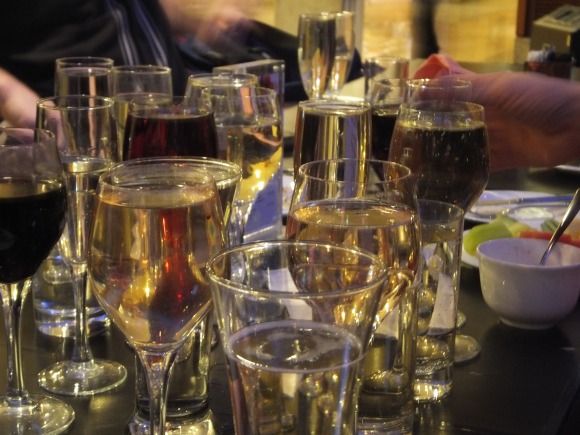
There’s a chain of buffet restaurants in Korea called Ashley. Ashley serve unlimited wine, including Prosecco. Ashley has a website which is in a mix of Korean and English. I just had a play and with some basic Korean I was able to locate a list of Seoul branches.
A little bit more classy was the all you can drink wine buffet which is held at Intercontinental Coex Hotel, at the Co-Ex mall. We went here for a friend’s birthday and we had fun drinking lots of wine and pretending to be classy. The buffet was served in the Lobby lounge and cost us ₩50,000 each.
->->->->->->->->->->
Where we stayed
For such a huge, international city, Seoul is actually not that great for accommodation. There’s not so many motels as elsewhere in Korea, the international chains are quite expensive and the hostels aren’t great.
For our first anniversary, J and I tried to go out in Hongdae. We knew there weren’t many accommodation options in Hongae, but we saw that there were loads in neighbouring Sincheon, so we decided to stay here. When we got there though (at about seven in the evening), we found that we couldn’t check in anywhere until ten – as the rooms were rented out in blocks of time so that young Koreans could use them for getting ready to go out to party, then the overnighters would check in once the pubs/clubs had closed.
There’s a good cluster of motels around Nambu bus station, and for our last few visits we have tended to stay in one of these, as they’re not over-priced but still pretty central.
Ciara 920 hostel, Insadong
The first time I stayed in Seoul was the night before my DMZ tour. I stayed on my own in Insadong.
I booked Ciara 920 hostel because it had great ratings on Hostelworld.com and because it was in a really good location. It wasn’t that great a hostel though. They emailed me to ask what time I would be arriving. I said I didn’t know but probably about four in the afternoon. I arrived at four thirty and the guy on reception told me off for being late. I was then told to read a big list of rules and given my key and the codes. The guy disappeared and I never saw him again.
The beds were comfy, but there wasn’t really any atmosphere, very few common room areas and the bathroom stank. There was nowhere to brush my teeth apart from the kitchen sink and because of the food catcher this was disgusting.
However, the location was great and it was good to be in the heart of Insadong where there are lots of bars, restaurants etc.
My bed in my dorm cost me 21,000 won (about £15).
BJ Guest House, Seong-Book Dong, close to Hyehwa
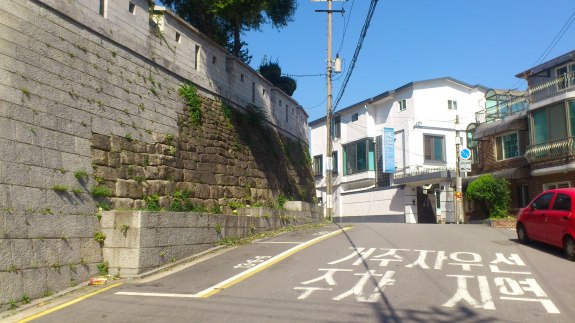
BJ Guest House was a much better hostel. We visited Seoul with a bunch of friends and we wanted to be in the Hyehwa area.
BJ Guest House was more of a home-stay than a hostel but it had a nice, friendly set up and was a good place to stay. They had a good living room with books and guides, the rooms were comfortable and warm and a basic breakfast was included.
The hostel is located near the old city walls which are interesting.
A standard twin or double room cost us ₩20,000 each per night (about £12).
Casaville Residence, Sinchon
Because accommodation is so hard to find in Seoul we pre-booked somewhere to stay for my birthday. The Casaville Residence offers serviced apartments, though the room we were in was just like a very nice hotel room.
It was an OK apartment but not really worth the cost. It was the kind of place that business people stay in for months, rather than a one night place.
The room cost us ₩120,000 (about £70).
www.casaville-shinchon.hotel-m.com
Art Hotel, Seocho, near Nambu bus station
In our second year of living in Korea we discovered that there’s a great cluster of motels around Nambu bus station, and so we tended to stay here, close to the bus terminal for Geoje.
J and I stayed in the Art Hotel after I flew in for my second year of teaching. It’s a good standard love motel, the beds were comfy, we had a jacuzzi bath, there was a computer and free wi-fi and, best of all, there was a Mapo-Galmeigi (the best barbecue restaurant in Korea) near by – so I was in heaven.
We liked the Art Hotel so much that we returned twice more to stay here.
The standard double room cost us ₩85,000 (about £50). We booked it through booking.com.
art-hotel.seoulhotelskorea.com
Tria Business and Boutique Hotel
J and I had always wanted to have a night out in Gangnam. We usually popped in for shopping or transport, but never stayed overnight – so we were determined to have a big party here; so we booked a night at the Tria Business and Boutique Hotel and arranged to meet our friends.
The only problem was that I got sick. Winters in Korea are harsh and most apartments are not well insulated and are damp. I got a chest infection and terrible cough that I just could not shift – and this happened to coincide with our night out.
But our bed at home was so uncomfortable and our apartment so small and damp, that we decided to use the room and the booking anyway, just so we could have some warmth and a little bit of luxury. And it was nice. The room at the hotel was big, the bed comfy, the hot shower was wonderful and it was a great place to be ill.
The Tria Business and Boutique Hotel is actually quite a way from Gangnam high street (about 20 minutes walk), but it was a nice place to stay in the city.
The room cost us about ₩100,000 (about £65), which for elsewhere in Korea is really expensive but an okay price for central Seoul.
Jimjilbangs
Jimjilbangs are Korean bath-houses where people can sleep on the floor overnight. It’s a strange idea and the floors are not that comfy, but if you’re travelling and just want somewhere cheap to rest your head for a few hours and a soak in a spa bath, then jimjilbangs are a good option to stay in.
The night before we caught the early bus to Sokcho we stayed in the Riverside Spa jimjilbang, which is by dong-Seoul bus station. You can find out all about this on the Sokcho page.
->->->->->->->->->->
Useful links
Groove Magazine is a magazine for ex-pats in Korea. It has wonderful, interesting articles about the country and good listings for events and night-life. Copies of the magazine can be found in bars and book shops across Itaewon and Hongdae. Groove does tend to be slightly Seoul centric – which for the purposes of this page is great! groovekorea.com.
Another great ex-pat listings magazine is 10 magazine. This can also be found in businesses around the city. 10 was not as in-depth or as produced as Groove, but it’s still a really useful source of up to date information for the city. www.10mag.com.
en.wikipedia.org/wiki/Seoul and wikitravel.org/en/Seoul
www.lonelyplanet.com/south-korea/seoul
www.frommers.com/destinations/seoul
www.roughguides.com/destinations/asia/south-korea/seoul
DISCLAIMER
Please note, some, if not much of this information may not be correct, or may be out of date. All these articles show is how we found these places when we visited and what we personally thought of each place. Where possible I will include links to site which will contain more up-to-date info. All of this is my own work and any opinion expressed is that of the author only.
If you think I’ve missed something important or have got something wrong, please let me know in the comments section below.
All photos copyright of J Clemo-Halpenny. If you would like to copy or reproduce any of these images, please email me to ask permission.

3 comments